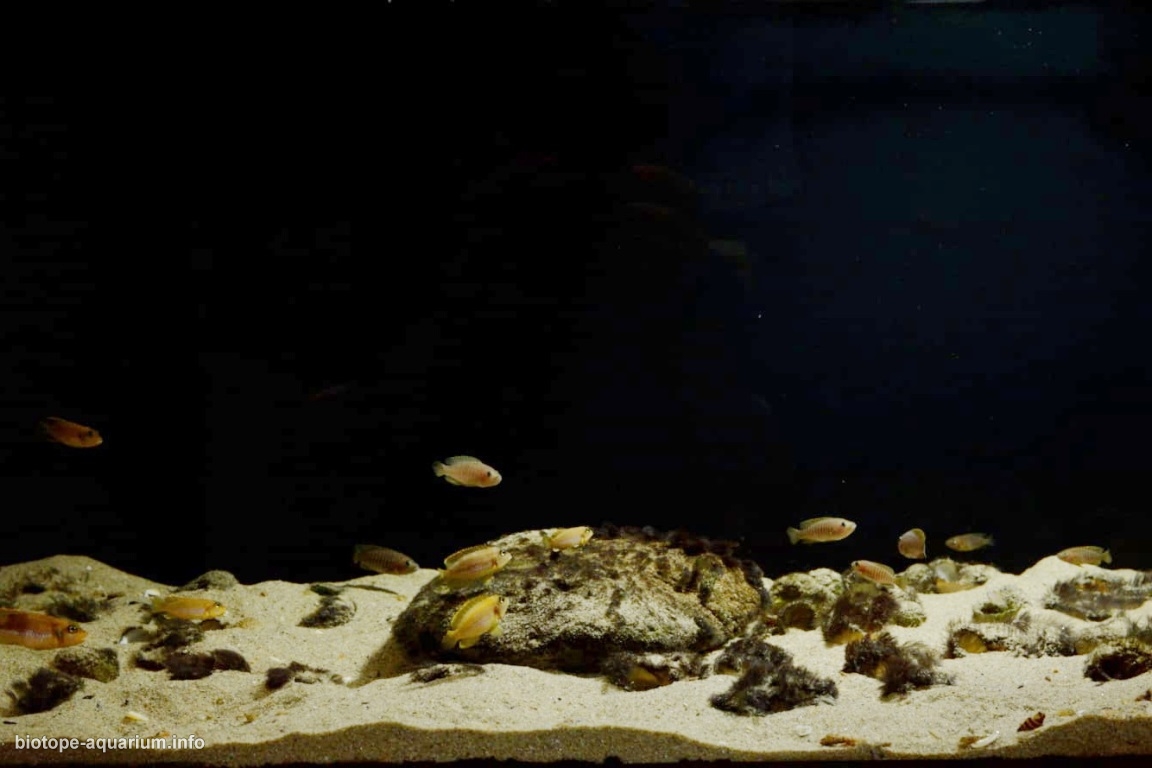Lake Tanganyika, sandy sedimentary bottom area in Ndole bay, Zambia
_th place in Biotope Aquarium Design Contest 2020

olume: 200l
Dimensions: 90x50x45
List of fishes: Neolamprologus multifasciatus (Boulenger, 1906)
Lamprologus ocellatus (Steindachner, 1909)
List of plants: N/A
Description of decorations: For decorating, I used extremely fine sand from the Black Sea along with srocks which are dividing very well the fish areas. The snail shells were collected from forest and belong to Helix Pomatia species. Had to choose this option as Neothauma species is not present in Romania. The algae were further generated by light, covering the shells and the stones.
Description of equipment: SunSun HW-303 external filter, 1400 l/hrs. with biological & mechanical material;
JBL ProTemp S300 heater;
Suspended lamp for lightning 10w,6500k.
Water parameters: Temperature: 25°C
pH: 8,5
GH: 16
Additional info: Once a week 30% of the water is changed. The filter is cleaned at 3 months
INFORMATION ABOUT BIOTOPE:
Description of the area surrounding the biotope: Lake Tanganyika is the largest African lake. It’s the second oldest freshwater lake in the world, and the second deepest after Lake Baikal in Russia. It is the longest freshwater lake in the world.
The lake is divided between four countries: Tanzania, the Democratic Republic of Congo, Tanzania and Zambia. It flows to Congo river and then further to the Atlantic Ocean.
Lake Tanganyika is situated within the Albertine Rift, the western branch of the East African Rift, and is confined by the mountainous walls of the valley. It is the largest rift lake in Africa and the second-largest lake by volume in the world.
It’s the deepest lake in Africa and holds the greatest volume of fresh water, accounting for 16% of the world’s available fresh water.
It extends for 676 km in a general north-south direction and averages 50 km in width.
The lake covers 32,900 km2 with a shoreline of 1,828 km a mean depth of 570 m (1,870 ft) and a maximum depth of 1,471 m (4,826 ft) (in the northern basin).
The lake holds at least 250 species of cichlid fish along with other 150 species. Almost all of the Tanganyika cichlids (90% of the species) are endemic to the lake. Together with the endemic cichlids, the lake holds invertebrate species such as: mollusks, crabs, shrimps, jellyfish, leeches.
This aquarium represents Ndole bay (Zambia area) located near Nkamba Bay in Nsumbu National Park on Lake Tanganyika. Ndole bay is part of Cameron bay.
Description of the underwater landscape of the biotope: Lake Tanganyika has different habitats. Tens meters away, the habitats of Ndole Bay change drastically and different species have evolved to adapt. In front of the beach, a habitat based on large slabs of rock and sand was found. Followed by these large slabs of rock, a large sandy plain begins.
To the east, as the depth increases, the bottom of the lake presents a dense area of sand and fine sediments, with fields of Neothauma snail shells.
The northern side of the beach, two small habitats have been created, each with its set of species, a coast filled by a dense canefield and small rocks.
On the south coast there is also a reed, but without rocks with a thick base of mud. Rock structures resembling a reef run parallel to the beach and are separated by bands of sand for only a few meters. It is a shallow area with a good water movement. A large number of fish inhabit rocky and sandy areas where they find protection, food, and their breeding grounds. Different species have different requirements in terms of territory.
Description of the parameters of the habitat: The water in Lake Tanganyika is alkaline, with a pH between 8.5 – 9.0 depending on the depth and alkalinity surrounding the 650µS. The water temperature of the lake is very stable, due to the large body of water. The surface temperature of Lake Tanganyika ranges from 23-27°C, and the hypolimnion temperature ranges from 23–24°C, although most fish inhabit areas with a temperature of 24-27°C.
List of fishes and invertebrates occurring in the nature biotope: Altolamprologus sp. „Sumbu” (Boulenger, 1898)
Lamprologus ocellatus (Steindachner, 1909)
Lepidiolamprologus cunningtoni (Boulenger, 1906)
Neolamprologus multifasciatus (Boulenger, 1906)
Neolamprologus tetracanthus(Boulenger,1899)
Telmatochromis temporalis (Boulenger, 1899)
Oreochromis tanganicae
Callochromis macrops
List of plants found in the nature biotope: N/A
Threats to the ecology: –
Sources of information:
https://www.youtube.com/watch?
https://www.youtube.com/watch?
https://www.youtube.com/watch?
